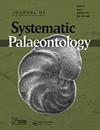中生代茎群琐罗亚斯德海星暗示了冠群的延迟辐射和对深海的适应
IF 2.2
2区 地球科学
Q3 EVOLUTIONARY BIOLOGY
引用次数: 0
摘要
摘要:琐罗星科(Zoroasteridae)是仅存在于深海环境(即深度超过200 m的深海环境)的海星的一个分支。在化石记录中,已经比较和/或将七个物种划归到琐罗星科,时间跨度从中侏罗世到中新世。本文描述了法国勒芒(Sarthe, les Mans) Cenomanian的一个新分类群Viridisaster guerangeri gen. et sp. nov.,并对两个中生代物种——侏罗纪Terminaster cancriformis和早白垩世Protothyraster priscus进行了重新评价。为了测试被认为是琐罗亚斯特龙的化石与现代分类群的关系,对6种最著名的化石物种和29种forcipulatacean物种进行了系统发育分析,其中包括4种琐罗亚斯特龙。定义现存琐罗亚斯特亚科的许多特征在新生代之前的化石记录中都没有出现。家族的姓氏仅为王室保留。Terminasteridae家族,包括terminasteria属和Alkaidia属,被发现为paraphyletic,在这里被拒绝。琐罗卡利达目,最初仅为琐罗亚斯特亚科而建立,被重新定义为Forcipulatida的姐妹分支,包括冠群琐罗亚斯特亚科及其茎类亲属。与新生代相比,中生代Zorocallida体型较小,表现出典型的幼代Zorocallida形态特征;因此,现代形态的出现很可能与变质演化有关。本文讨论了始新世以后Zoroasteridae的古生态学及其对深海环境的限制。http://zoobank.org/urn:lsid:zoobank.org:pub:1755AFC6-198F-45F2-A2F6-011EAC6BE10FKeywords:白垩纪asteroideaechinodermataphylogenynew分类群作者感谢为标本的获取提供帮助的收集管理人员:Nicolas Morel (MHNLM);沃尔特·埃特和塞尔吉奥·克本文章由计算机程序翻译,如有差异,请以英文原文为准。
Mesozoic stem-group zoroasterid sea stars imply a delayed radiation of the crown group and adaptation to the deep seas
AbstractThe family Zoroasteridae is a clade of extant sea stars found exclusively in deep marine environments (i.e. bathyal environments deeper than 200 m). In the fossil record, seven species have been compared and/or assigned to the Zoroasteridae, on a time span ranging from the Middle Jurassic to the Miocene. This study describes a new taxon, Viridisaster guerangeri gen. et sp. nov., from the Cenomanian of Le Mans (Sarthe, France) and reappraises two Mesozoic species, the Jurassic Terminaster cancriformis and the Early Cretaceous Protothyraster priscus. To test the relationships of the putative fossil zoroasterids with modern taxa, a phylogenetic analysis was performed combining six of the best-known fossil species and 29 forcipulatacean species, including four Zoroasteridae. Many of the characters that define the extant Zoroasteridae do not appear in the fossil record before the Cenozoic. The family name is maintained for the crown group only. The family Terminasteridae, that accounted for the genera Terminaster and Alkaidia, is found paraphyletic and is rejected here. The order Zorocallida, initially erected for the family Zoroasteridae only, is redefined as the sister clade to the Forcipulatida that includes the crown-group Zoroasteridae and its stem relatives. Mesozoic Zorocallida are small in size compared to the Cenozoic Zorocallida, and they express morphological characters that are typical of juvenile Zoroasteridae; thus, the emergence of modern forms is likely associated with peramorphic evolution. The palaeoecology of the Zoroasteridae and their restriction to deep-sea environments after the Eocene is discussed.http://zoobank.org/urn:lsid:zoobank.org:pub:1755AFC6-198F-45F2-A2F6-011EAC6BE10FKeywords: CretaceousAsteroideaEchinodermataphylogenynew taxon AcknowledgementsThe authors are grateful to the collection managers who facilitated access to the specimens: Nicolas Morel (MHNLM); Walter Etter and Sergio Kühni (NMB Basel); Timothy A. M. Ewin (NHMUK); Christian Meister (MHNG); Marc Eléaume and Pierre Lozouet (MNHN); Eric A. Lazo-Wasem and Lourdes Rojas (YPM). We thank the two anonymous reviewers for their comments that helped improve the manuscript. Marine Fau received financial support from the Department of Geosciences of Fribourg University during the period 2016–2020, and received a grant from the program Synthesys (GB-TAF-6581) for a visit to the Natural History Museum, London, in June 2017.Disclosure statementNo potential conflict of interest was reported by the author(s).Supplemental materialSupplemental material for this article can be accessed here: https://doi.org/10.1080/14772019.2023.2243268.Associate Editor: Erin Maxwell
求助全文
通过发布文献求助,成功后即可免费获取论文全文。
去求助
来源期刊
CiteScore
5.30
自引率
7.70%
发文量
31
审稿时长
>12 weeks
期刊介绍:
The Journal of Systematic Palaeontology publishes papers that provide novel and impactful results in phylogenetics and systematics and that use these results in ways that significantly advance rigorous analyses of palaeogeography, palaeobiology, functional morphology, palaeoecology or biostratigraphy. Papers dealing with theoretical issues or molecular phylogenetics are also considered if they are of relevance to palaeo-systematists. Contributions that include substantial anatomical descriptions, descriptions of new taxa or taxonomic revisions are welcome, but must also include a substantial systematics component, such as a new phylogeny or a revised higher-level classification. Papers dealing primarily with alpha-taxonomic descriptions, the presentation of new faunal/floristic records or minor revisions to species- or genus-level classifications do not fall within the remit of the journal.

 求助内容:
求助内容: 应助结果提醒方式:
应助结果提醒方式:


